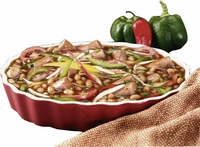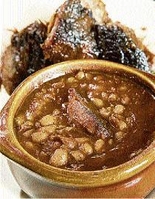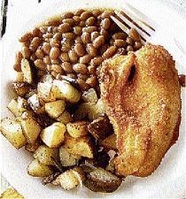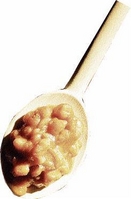
Vienna sausages swimming in baked beans is a breakfast staple in many homes. - Contributed
Baked beans are often placed on a shopping list as an everyday food item. Beans have been used in basic meal preparation in the home or for institutional food service. However, baked beans have had a long history of sophistication in culinary preparations and are being used extensively in gourmet meals.
Baked beans are made from beans stewed in a sauce. Commercial baked beans are made from haricot beans, or navy beans, and packaged for sale in the sauce.
According to Allison Kreitler, writing in Fine Cooking, her opinion of baked beans as horrible food changed when she tasted her friend's home-made baked beans with tamarind and smoked turkey with a not-too-sweet slightly sour taste. Today, Kreitler is developing her baked beans recipes, ensuring that the combinations of sweet, tangy and even bitter notes strike the right balance of flavour.
History

Baked beans can be used to complement the main course, especially at barbecues.
The beans have been popular in native North America before the Pilgrims landed on the eastern shores. Beans, squash and maize were grown together in a three-sister method of farming. Native Americans flavoured their baked beans with maple syrup and bear fat, and baked them underground in pits covered with hot rocks.
The Pilgrims most likely learned how to make baked beans from the Native Americans, substituting molasses and pork fat for the maple syrup and bear fat. Since Pilgrim women were not allowed to cook on Sunday because of religious beliefs, baked beans were ideal to cook from the night before and kept warm until next morning.
Blend of cultures
Baked beans were later introduced to Italy and France in the early 1500s. The blend of cultures of North America, Italy and France gives rise to delectable baked-bean culinary fare today.
In the United Kingdom (UK), the term baked beans refers to canned beans in tomato sauce. The Heinz brand has become synonymous with baked beans, a staple in the diet of UK residents. Baked beans are used with other foods to fill sausages, as a side dish with bacon or as a topping for pizza. The British eat beans on toast for tea and may add extras like egg, grated cheese or tuna, which may also be part of a full English breakfast.
Underground cooking

A hearty lunch of fish fillet, fried potatoes and baked beans. - MCT photos
Traditional cooking method for beans was to bake them in a ceramic or cast-iron pot. In logging camps in places like Maine in the United States (US), bean-hole cooking developed where beans were placed in stone-lined fire pits where bean pots were buried to slow-cook overnight or up to two days. This practice popularised the crock pot or slow cooker. Southern states were known for tangier beans because of yellow mustard, which was added. Beans were also combined with ground beef for entree dishes.
Pork and beans
Pork and beans were developed as one of the first convenience foods. Canned salt pork and beans were served to the US army during the American Civil War in the 1860s. In New England, baked beans may be sweetened with maple syrup and a small piece of pork added and allowed to cook for a whole day.
Baked-bean dishes around the world
Mexico and Latin America: Heavy use of baked beans in the diet. They also use black beans and pinto beans in several dishes.
United States: Boston baked beans, New England baked beans, barbecue baked beans.
Canada: Quebec baked beans.
France: Cassoulet, Jersey beans, Guernsey beans.
Brazil: Feijoada.
Nutrition
Although beans were once called 'poor man's meat', they have recently undergone a renaissance of popularity through the demand by health-conscious consumers who enjoy this economical source of versatile and delicious nutrition.
One cup of cooked dry beans supplies fibre, protein, calcium, iron and thiamine in significant amounts.
Dry beans are a high source of protein, second only to animal protein.
Dry beans contain no cholesterol and only a small amount of fat.
Beans are a rich source of soluble fibre, the same gummy fibre found in oat products. The fibre acts in the body to lower cholesterol and blood sugar.
Cooking with Dry Beans
Baked beans are usually made from navy beans and sometimes sweetened with brown sugar or molasses to become a popular side dish in the United States.
You should have time on your hands to make home-made baked beans. Kreitler advises that "beans are like sponges ready to soak up lots of good flavour if you give them enough time". Kreitler also allows the beans to sit overnight after baking to absorb their natural flavours and to let their starches thicken the sauce.
Soak beans overnight to begin softening the skin. The overnight method allows the dried beans to fully hydrate, resulting in a more pleasant texture.
To quick-soak, boil beans in plenty of water for two minutes and then allow them to stand for one hour.
Consider cooking a large batch of beans when you do have time and freeze the drained beans in meal-size portions. This way, you will always have beans ready for cooking.
The type of Michigan beans you use for baked beans will not affect the outcome of the product. Small white beans, navy beans and Great Northern beans are all equally satisfying, with no difference in texture.
Gently cook beans to keep skins intact during baking and do not stir too often. During the final cooking, resist the temptation to rush things by boiling or simmering too vigorously.
Taste five beans when checking for doneness. Kreitler posits that beans cook at different rates - even in the same pot - so it is best to try a few at a time. Testing should be done frequently, as cooking times vary. Overcooked beans will be mushy with split skins.
There is a role for acids in the cooking of beans. Beans cooked in acidic tomato sauce dramatically increase the cooking time. This is because acids slow down the process by which bean skins soften. However, since baked beans need a long time to cook under any condition, it is a good idea to stick to the tomato sauce and add 1/2 cup of cider vinegar, which keeps the beans nice and firm and also helps to balance the sweetness of the molasses and maple syrup.
If other liquids are used, add them when they are almost fully cooked.
Once all the ingredients are combined, Kreitler bakes beans uncovered so the cooking liquid can begin to reduce and intensify.
Kreitler recommends adding a dash of cider vinegar, sherry or bourbon for a "burst of bright flavour".
Baked beans usually have salt pork as a standard ingredient. Instead of fatty salt pork, substitute thick-cut smoked pork to give your meal more flavour. Kreitler agrees that homemade baked beans need plenty of meat, preferably cured pork like thick cut bacon or ham hocks. She adds that the salty pork cuts through the starchiness of the beans. She browns the pork and saute the aromatics in the pork drippings and then add spices, a cooking liquid and the beans. (www.michigan.gov/mda)
Grandma's Baked Beans
Grandma's practice does make perfect, as her baked beans made thousands of times must be nearing perfection. They are sweet, well browned and thick, and she always makes them with red kidney beans and molasses.
1 pound red kidney beans
1 teaspoon salt
1/3 cup sugar (granulated or brown)
4 tbsps catsup or ketchup
3 tbsps molasses
1 tsp dry mustard
1 piece salt pork about 1-1/2-inch square, scored
Soak beans overnight in water to cover. In the morning, pour the water off, cover with fresh water, add the salt, and boil until beans are soft. Drain beans in a colander. Place beans in a bean pot or casserole, add water to cover, and add rest of ingredients, stirring well. Bake uncovered at 400F until beans are brown on top (about half an hour), then cover and bake at 350F about two hours longer.
Serves six.
Source: http://www.almanac.com/recipe/baked-beans
Variation: Baked beans may be slow-cooked with a variety of herbs and spices and are typically stewed instead of baked. Meat, such as bacon, and vegetables, such as tomatoes, can also be added to the stew.
HAWAIIAN-STYLE BAKED BEANS

Canned beans are cooked and ready to use, but make sure to drain and rinse the beans before adding them to recipes.
2 cans baked beans in tomato sauce
1 can pineapple chunks, drained
1-2 tbsps light brown sugar
11/2 tsps mild mustard
1/4 tsp salt
Dash of ground cloves
Combine ingredients, pour into one quart casserole. Bake uncovered in 375 oven for 50 to 55 minutes or until beans are hot, stirring occasionally.
Makes four to six servings.
Source: cooks.com
Baked-bean trivia
One of our oldest foods, beans was eaten often by the ancient Greeks, who would hold a bean feast to honour Apollo.
Of the more than 14,000 specimen of beans in the legume family, only 22 are grown for human consumption.
The navy bean is the official vegetable of Massachusetts, and in 1993 the state legislature declared it the original bean of Boston Baked Beans.
Boston became famous for baked beans during colonial days.
In 1876, B&M baked beans were the first baked beans to be sold in cans. The Burnham & Morill Company canned baked beans for use by fishermen who worked their fishing fleet out of Portland, Maine. (foodreference.com/html/)
July is National Baked Beans Month in the United States.
Top manufacturers of canned baked beans: Heinz, Bush, Van Camp's. Michigan leads the nation in the production of dry edible navy beans, black beans and cranberry beans.